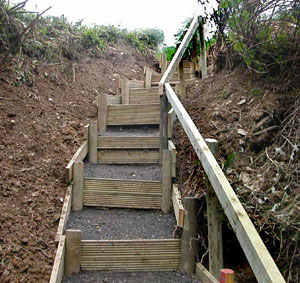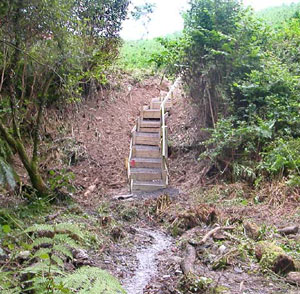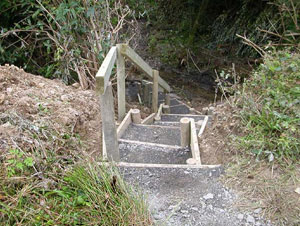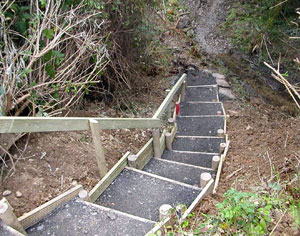Woodland steps – part 2

Steps can make a nice feature as well as fulfilling a practical purpose: taking you from one level to another, perhaps bridging a change in levels between two sections of your woodland track, where the slope is too steep to scramble up and down. In situations where the steps span a vertical distance of more than about six feet, a conventional flight of steps is far safer than the ladder steps described last time.But, before you start, consider the alternatives. Carving steps out of heavy clay or stony ground, most likely with tree roots to contend with too can be very heavy going. So, take a good look at the surrounding area. Would it be possible to reroute your track around the steep part, or make progressive changes in level though a series of single steps at different points along the track?
If not, or if you just like the idea of a flight of steps, then here’s how to do it:-
- Survey carefully. Figure out where you want the steps to begin and end. Sometimes you may be lucky enough to be able to start from your chosen point and then cut out a series of even height, gentle steps which end where they end. Other times, as with the example shown, the start and end points may be dictated by the surroundings. In this case, the steps started at the side of a small stream and ended at the side of the main, stoned track through the woodland. This resulted in quite a steep flight of steps with the vertical rise on individual steps being greater than optimum, but this was unavoidable
- In situations like this, you can gain yourself a bit of ground and thus soften the climb, by building changes of direction into the flight. These changes can be quite subtle; we’re not suggesting a spiral staircase effect! This has an added benefit; a straight flight of steps, particularly if they are steep, can be quite intimidating, particularly for children. A curved flight of steps feels more user-friendly
- Always take a good look from both the top and the bottom before finalising your route. Once you have decided, its time to start digging
 Work from the bottom up. It might be tempting to start from the top, just chucking the soil downhill, but this is going to result in having to shift the same earth several times over, is dangerous on steep slopes and puts unnecessary strain on your back and legs. Working from the bottom allows you to throw the bulk of the soil off to the sides of the steps. Yes, a small quantity may fall back onto the previous step, but this is going to be tamped down anyway. Also, by standing on one step whilst you are cutting out the next, you are starting the process of compacting down the soil
Work from the bottom up. It might be tempting to start from the top, just chucking the soil downhill, but this is going to result in having to shift the same earth several times over, is dangerous on steep slopes and puts unnecessary strain on your back and legs. Working from the bottom allows you to throw the bulk of the soil off to the sides of the steps. Yes, a small quantity may fall back onto the previous step, but this is going to be tamped down anyway. Also, by standing on one step whilst you are cutting out the next, you are starting the process of compacting down the soil- The width of the steps is up to you, but obviously the wider you make them, the more digging is required. Two to three feet is a good size for most purposes. The depth of the steps and the vertical rise will to some extent be determined by the steepness of the slope and how much space you have to play with, but where you have the luxury of choosing these things, go for a front-to-back depth of at least two feet and a rise of 8 – 10 inches
- The vertical face of each step is shored up with timber. A couple of lengths of decking board is ideal. These are wedged in place behind ‘stobs’ positioned at either end of the steps. The stobs can be made from off-cuts from fencing stakes. Round stobs are much easier to work with than square ones. Stobs should either be cut off flush with the surface of the retaining board or left projecting up by at least a foot. Don’t leave just an inch or two projecting up because someone will trip and fall – probably you!
- Depending on the nature of the ground to the sides of the steps, you may need to put retaining boards in here as well. These can either be wedged in place or maybe screwed to the ends of the vertical boards or to the stobs, although you might need to dig away a little bit of earth in order to get your drill into position
- You now have your basic flight of steps. Now for the finishing touches
 A sturdy handrail – at least down one side – will greatly increase the safety and usability of the steps. Lengths of planed timber, [you could use sawn timber but would need to sand it or suffer years of splinters] 2” x 3” will do for the rails, securely screwed to fencing stakes
A sturdy handrail – at least down one side – will greatly increase the safety and usability of the steps. Lengths of planed timber, [you could use sawn timber but would need to sand it or suffer years of splinters] 2” x 3” will do for the rails, securely screwed to fencing stakes- The parts of the steps which you walk on – the treads – need tamping down firmly. They can be left as bare earth, but a 2” thick layer of chippings laid onto a square of landscape fabric produces a much more durable, cleaner and safer result. Chippings also level out any uneven-ness in the tamped down earth. If you are going for this option, then you really need to bash the soil down hard [or shave a bit more off] to create the room for the depth of chippings.
And that’s it. Now you can ascend/descend those tricky areas of your woodland on your feet rather than bumping along on a different part of your anatomy.
Comments are closed for this post.
Discussion
Where is part 1??
Excellent article.
Am really looking forward to tackling our steps at the start of our woodland path.
2 metre rise and then 70 metres of gentle slope.


using the search facility : https://www.woodlands.co.uk/blog/woodland-activities/woodland-steps-–-part-1/
E L Wisty
24 April, 2023